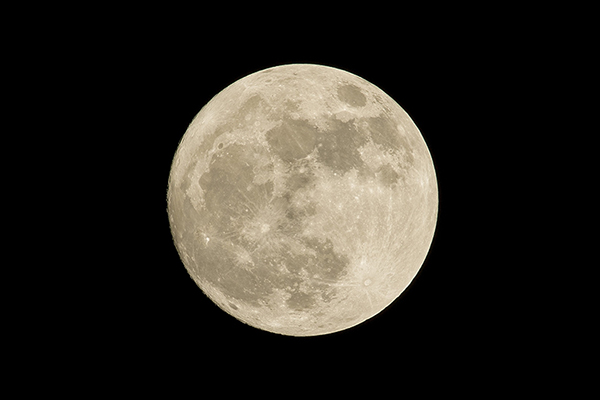- Author Andelka Subasic

If the Moon is connected to rivers, tides and ebbs and there is more than 70% water in a person, why wouldn't it affect us as well. This is why there are good and bad moods that depend on the position of the Moon.
Man and Earth are an inseparable part of the infinite Universe. Earth lives in the common rhythm of other planets. Tides, solar activity, energy we receive from the Sun and other planets are factors that condition life on Earth. Although the gravitational influence of the Sun on the Earth is much greater than that of the Moon due to the large mass of the Sun, the tidal influence of the Moon is greater, primarily due to its proximity. The mean distance of the Moon from the Earth is 384,405 kilometers. The diameter of the Moon is 3,476 km. The Moon is one of the largest satellites in the solar system, which is why there are many visible influences of the Moon on the Earth as its parent planet. Just as the Moon illuminates the surface of the Earth due to the reflection of the Sun's rays, the Earth also illuminates the Moon in the same way. This phenomenon is called "ash light", and it can be clearly observed in the small phase of the Moon (quarter). The Moon always shows us the same side of its surface.
The known influences of the Moon on life on Earth are:
The most famous proven influence is that on the tides, which was also explained by Marco Antonio de Dominis. With its gravitational influence, the Moon attracts the Earth's surface facing it more than the center of the Earth, thus causing the oceans to rise. On the other side, the water mass facing away from the Moon is released, and thus the rhythmic rise and fall of the water surface occurs. Tides further influence many biological processes.
It has been proven that fermentation is increased at the time of the Full Moon, so the most favorable moment for bottling wine is the waning phase of the Moon (New Moon).
It has been proven that the rate of sedimentation of mothballs is the highest for the New Moon and the lowest for the Full Moon
Dr. Peterson proved that the blood composition changes under the influence of the Moon's "radiation" or electromagnetic field. The Moon also affects the degree of blood clotting.
Oyster shells open and feed just as the Moon passes overhead. Insects, rodents, animals - all are influenced by the Moon and its changes.
It is known that the Moon affects our psychological states: aggressiveness, melancholy, tearfulness, nervousness, etc. Even ancient civilizations established that the Moon is strongly connected with motherhood, fertility and childbirth. It is a fact that the menstrual cycle in women lasts as long as one lunar month and this is not a coincidence. Even the Latin name "mensis" means month, and is the name for menstruation.
The strongest influence of the Moon is on people who live in primitive human communities, far from the influence of civilization. Apart from its influence, there is a very strong social factor today, stress, technical modernization and urbanization, which disrupts the natural balance.
The Moon is the Earth's only satellite, and in astrology it is treated as a planet, orbiting the Earth, which at the same time orbits the Sun.
The New Moon is when the Moon is between the Earth and the Sun so that we can see it, and the Full Moon occurs 14 and a half days after the New Moon, then it is completely illuminated by the Sun. (In astrological terms - when your Sun and Moon are in the same sign, then you were born in the time of the New Moon.)
The Full Moon rises at sunset and sets at sunrise. When the Moon is directly opposite the Sun and obscures it, a solar eclipse occurs - an exciting event that ancient astrologers considered extremely significant, while today this natural phenomenon is not given such importance. (In astrological terms: when in your horoscope the Sun and the Moon are in two opposing signs, for example Leo-Aquarius or Taurus-Scorpio or Virgo-Pisces, etc., you were born at the time of the Full Moon)
The Nodes of the Moon are abstract points where the Moon's path and the eclipse meet. The point where the Moon intersects the Sun's path on its way northward is called the North Node of the Moon or the Dragon's Head, and the opposite point is the South Node of the Moon or the Dragon's Tail.
The Moon, the carrier of the Sun's energy, bestows people born at night with more pronounced psychological characteristics of the sign in which the Sun is located. So, for example, a person who was born at night during the reign of the zodiac sign Leo, will be a more emotional Leo, with more empathy and a protective instinct, will emphasize feelings, that is, what cannot be seen. A daytime birth will primarily emphasize the visible needs of a person with the Sun in Leo, such as the need for: leadership, dominance, the center of attention.
In childhood, the position of the Moon is more obvious because at that time we are all more spontaneous, we show what we feel and think more easily, and upbringing and other factors have not yet exerted their great influence.
The Sun and the Moon work together and describe the connection between the physical and the psychological.
Most of you know which zodiac sign the Sun occupied at the time of your birth. With this, you are familiar with the way of expressing your own individuality. Knowing the position of the Moon in your horoscope will reveal the areas of your emotional ups and downs.

